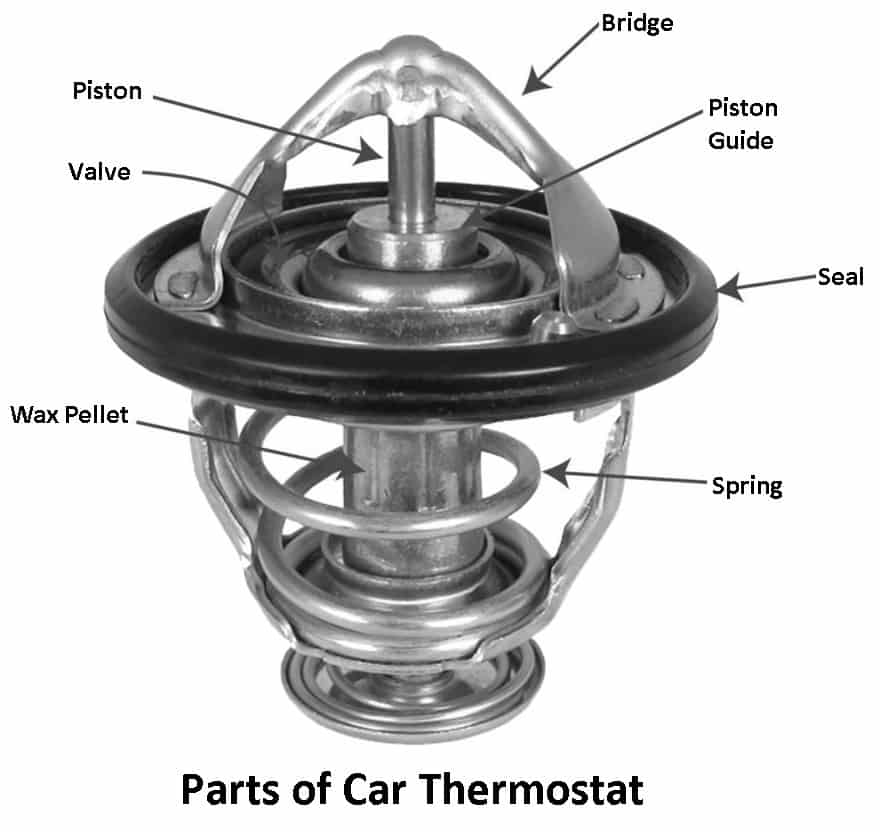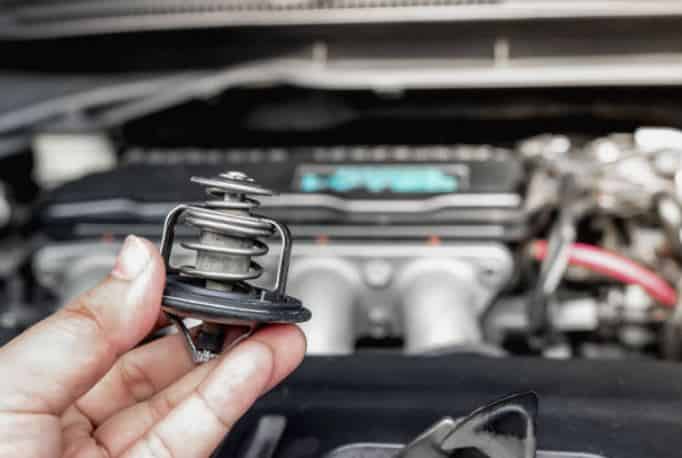In this article, you’ll learn about How Does a Car Thermostat Works? Its Diagram, Parts, Function, Types, Symptoms, and Replacement are explained in detail.
Also, you can download the free PDF file of this article at the end.
What is Car Thermostat?
Inside the engine of a car, many parts are intricately connected. As you drive your car at high speed, it increases the temperature inside the engine. To keep the engine temperature cool and stable, a part is used called a thermostat.
A thermostat is a valve used in the water cooling system to regulate the circulation of water in the system to maintain the average working temperature of the engine during different operating conditions.
When the engine is started from cold, the thermostat prevents the flow of water from the engine to the radiator so that the engine reaches the normal working temperatures. Generally, the car thermostat does not permit water below 70°C. After attaining the higher temperature, the thermostat allows the water to the radiator for cooling.
The car thermostat is located between the engine and the radiator. When this is damaged, the entire cooling system of the engine will start to fail, which can be serious. Since it is a crucial component of the engine cooling system, it is essential to understand how they work. So let’s get started.
Checkout: What is Air Cooling System, and How It Works? [Explained]
Parts of Thermostat
Following are the essential parts of a thermostat:
- Seal or gasket
- Spring
- Wax element
- Charge cylinder
- Secondary or by-pass valve
- Air bleed

#1 Seal or Gasket
A seal prevents any unwanted material from flowing into the main thermostat valve. The seat on which the seal sits must be clean for the seal to function correctly.
#2 Spring
The spring is an essential part of the thermostat, which helps to keep the valve closed when the coolant is not hot.
#3 Wax Element
It is the thermostat core. It converts heat energy into mechanical energy using thermal expansion when the wax melts.
#4 Charge Cylinder
The charge cylinder is filled with wax that begins to melt (from a solid to a liquid state) when the temperature of the engine’s cooling water rises.
#5 Secondary or By-pass Valve
When the by-pass valve is open, cooling water passes through the engine’s radiator and circulates within a closed circuit. As the engine cooling water temperature rises, it begins to close, and the cooling water is directed toward the radiator.
#6 Air Bleed
Air bleed is used to remove air from the cooling water system. It is ensured that the air bleed is kept in the highest position when the thermostat is installed, as this is where the air will collect. Air bleed is rarely used in some types.
Read Also: Common Problems of Cooling System [How to Detect Them]
Function of Thermostat
The primary function of the thermostat is to control the engine’s working temperature. The engine can be saved from overheating and over-cooling by using a thermostat. When the engine is cool, the thermostat prevents coolant from flowing.
This allows the engine to reach its working temperature faster. In addition, it ensures that the coolant absorbs heat before it enters the radiator. Lastly, the thermostat controls the circulation of coolant in the overall engine. It works in two states that are closed state and the open state.

Thermostat Valve is Closed
When the engine is cooled, the thermostat turns off (closed); There is no current through the radiator. The small thermostat by-pass valve is open, and the coolant circulates through the engine’s by-pass tube and the vehicle heating system. This permits the engine to warm up faster.
Thermostat Valve is Open
The thermostat valve slowly opens as the engine warms up to near operating temperature, allowing coolant to flow through the radiator. The coolant enters the top part of the radiator and cools as it flows through it. The water pump draws the cooled coolant back to the engine.
In cold weather conditions, the thermostat shuts down again if the engine temperature drops to the lower limit of the operating range (194 °F or 90 °C).
Many modern vehicles use an electronically controlled valve known as a “coolant control valve” instead of a thermostat. The coolant control valve works the same way; it is only operated by the engine computer and is more precise.
Types of Thermostats
Following are the types of thermostats:
- Bellows type thermostat
- Wax type thermostat
#1 Bellows Type Thermostat
It consists of metallic bellows filled with a volatile liquid like acetone and alcohol, which boils between 70-80°C. A valve is attached to one end of the bellow. When the engine is cold, the valve closes its outlet passages and does not allow water to reach the radiator but circulates through the by-pass port to the engine.
When the engine temperature rises, the water reaches the working temperature, the volatile liquid expands in the bellow and opens the valve, and allows the water to the radiator for cooling, during this the by-pass valve is closed.
When the engine cooled sufficiently it causes the cooling of the bellow which make the vapor present condensed. This causes a reduction in pressure; thus, the valve closes, stopping the cooling liquid flow. Therefore, it controls the flow of water through the radiator as per the engine’s cooling requirements.
#2 Wax Type Thermostat
In a wax thermostat, as the coolant is heated, it transmits its heat to the copper-loaded wax having a high coefficient of volumetric thermal expansion, which expands so that the rubber plug contracts against the plunger and exerts a force on the plunger to move upward.
This upward movement of the plunger opens the valve, and the coolant flows through the radiator for cooling. On cooling, the valve automatically closes due to the spring action of the rubber plug.
Read Also: What are the different types of Engine Valve [Explained]
Symptoms of Car Thermostat
The thermostat must be in the correct position for the engine to function precisely. If you see any signs of a thermostat failing, your car needs immediate service. Following are the common symptoms of a car thermostat:
- Unusual temperature reading
- Strange engine noises
- Engine running inefficiently
- Leakage of coolant
- Rust and deposit build-up

#1 Unusual Temperature Reading
A car engine can overheat for many reasons, including a leak in the cooling system, a blocked drain in the cooling system, or a bad thermostat. If the thermostat remains closed, the engine coolant cannot reach the radiator and, therefore, cannot cool.
This will cause the engine to overheat as the coolant flow will be blocked. You can see this on your car’s dashboard with a display of rising temperature, and you won’t be able to drive for more than 10 minutes before it warms up again.
#2 Strange Engine Noises
As your car engine overheats, a decrease in coolant flow due to a thermostat failure can also cause a strange noise. The noise can be heard as a boiling, a rumble, or a knocking sound from the engine or radiator.
Therefore, you probably have a bad engine thermostat when you hear such noises. In this case, you need to contact a mechanic immediately.
#3 Engine Running Inefficiently
If the engine is running at lower than average capacity, it may be because the thermostat is failing to cut off coolant entry to the engine. The thermostat can be clogged in an open position.
Due to this, too much coolant can enter the engine, causing the temperature to drop far below the required level. If so, be sure to check your thermostat for damage.
#4 Leakage of Coolant
The thermostat will fail to function if installed incorrectly. Or, if the thermostat is not working correctly, the hot coolant in the engine coolant chamber will find an escape route due to too much pressure. As you know, hot air rises, and water boils when heated and forms steam.
When the coolant overheats and the pressure gets too high, it can strike the weak points and cause a leak. Coolant is often squeezed out of the radiator tank. If you notice coolant leaking around the mounting surface of your car, take this as a sign to reinstall your thermostat.
#5 Rust & Deposit Build-up
Detecting this symptom requires a certain amount of familiarity with what’s under the car hood. If the car thermostat is rusting or off when you check your engine cooling system, it is a sign that your thermostat may fail soon.
When the thermostat rusts or becomes clogged, replace it to prevent damage to the engine. Using the proper coolant for your car can avoid damage to the cooling system and extend the life of your car’s thermostat.
Read Also: The Basic Car Body Parts and Their Functions [Names] PDF
Replacement of Car Thermostat
Replacing a car thermostat is simple and relatively inexpensive, so you may want to try this task out before taking more extreme measures. Just make sure you do this when your engine has thoroughly cooled down. When replacing, you need to follow the steps below:
- First, you must locate your car thermostat if you haven’t already.
- Place a bucket under where you are going to work. Because the fluid will get out, you can store it in a bucket.
- Now, you have to remove the clamp.
- After that, remove the hose. This is where some of the fluid will escape and flow into your bucket.
- Remove the bolt holding the thermostat housing and remove the old thermostat.
- Now, unscrew the old gasket and put the new gasket in place.
- After placing a new gasket, insert and secure the new thermostat.
- Replace the hose and hose clamp. If your hose uses a clamp screw, screw it on, but not tight enough.
- Replace any fluid that drains from the hose by pouring it from the container into the radiator fill hole or coolant reservoir.
Check out the article: Detailed Explanation in Car Thermostat Replacement
How To Test Your Car Thermostat?
Testing a car thermostat can be done without even removing the component. The engine computer usually monitors modern cars’ thermostats (PCM). If a fault occurs, the check engine light will turn on.
Some mechanics test the thermostat by measuring the temperature of the upper and lower radiator hoses. An infrared thermometer can be used to perform the test, which helps monitor the engine temperature.
Wrapping It Up
As we already said, the primary function is to control coolant flow while keeping the engine at optimum temperature. This coolant flow is blocked until it reaches the temperature where the thermostat opens. Thermostats generally have a lot of advantages over the cooling system of vehicles.
So for now, I hope I’ve covered everything about “Car Thermostat“. If you still have any doubts or questions on this topic, you can contact us or ask in the comments. If you like this article then please share it with your friends.
Want free PDFs direct to your inbox? Then subscribe to our newsletter.
Download PDF of this article:
You might like to read more in our blog:
Its okayyy
I like it ❤️
Thanks.